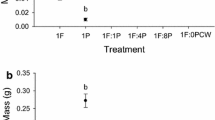Abstract
Grazing rates of the isopod Idotea baltica on Fucus evanescens and F. vesiculosus (Phaeophyta) were quantified in laboratory feeding preference experiments. Fucus species were offered alone (no-choice) or simultaneously (choice). In three of four no-choice experiments and in all four choice experiments, I. baltica significantly preferred F. vesiculosus to F. evanescens. F. evanescens recently immigrated into Kiel Fjord and has increased in abundance since 1990. One possible reason for the competitive success of this species may be that, compared to F. vesiculosus, it is less preferred by I. baltica, the most abundant mesograzer at the study site.
Similar content being viewed by others
References
Anonymous (1990) Vegetationsuntersuchung in der Kieler Förde 1982–1990. Teknisk Forvaltning Sonderjyllandsamt, Sonderjylland, pp 1–76
Arrontes J (1990) Diet, food preference and digestive efficiency in intertidal isopods inhabiting macroalgae. J exp mar Biol Ecol 139: 231–249
Barker KM, Chapman ARO (1990) Feeding preferences of periwinkles among four species of Fucus. Mar Biol 106: 113–118
Bokn TL, Lein TE (1978) Long-term changes in fucoid association of the inner Oslofjord, Norway. Norw J Bot 25: 9–14
Bokn TL, Murray SN, Moy FE, Magnusson JB (1992) Changes in fucoid distribution and abundances in the inner Oslofjord, Norway: 1974–80 versus 1988–90. Acta phytogeogr suec 78: 117–124
Brawley SH (1992) Mesoherbivores. In: John DM, Hawkins SJ, Price JH (eds) Plant-animal interactions in the marine benthos. Claredon Press, Oxford, pp 235–263
Brawley SH, Fei XG (1987) Studies of mesoherbivory in aquaria and in an unbarricaded mariculture farm on the Chinese coast. J Phycol 23: 613–623
Broenmark C (1985) Interactions between macrophytes, epiphytes and herbivores: an experimental approach. Oikos 45: 26–30
Chapman ARO, Johnson CR (1990) Disturbance and organization of macroalgal assemblages in the northwest Atlantic. Hydrobiologia 192: 77–121
Denton AB, Chapman ARO (1991) Feeding preferences of gammarid amphipods among four species of Fucus. Mar Biol 109: 503–506
Duffy JE (1990) Amphipods on seaweeds: partners or pests? Oecologia 83: 267–276
Haathela I (1984) A hypothesis of the decline of the Bladder-Wrack (Fucus vesiculosus L.) in SW Finland in 1975–1981. Limnologica, Berlin 15: 345–350
Hay ME, Renaud PE, Fenical W (1988) Large mobile versus small sedentary herbivores and their resistance to seaweed chemical defence. Oecologia 75: 246–252
Kangas P, Autio H, Hällfors G, Luther H, Niemi Å, Salemaa H (1982) A general model of the decline of Fucus vesiculosus at Tvärminne, south coast of Finland in 1977–81. Acta bot fenn 118: 1–27
Kangas P, Niemi Å (1985) Observations of recolonization by the Bladder-Wrack, Fucus vesiculosus, on the southern coast of Finland. Aqua fenn 15: 133–141
Kautsky N, Kautsky H, Kautsky U, Waern M (1986) Decreased depth penetration of Fucus vesiculosus (L.) since the 1940's indicates eutrophication of the Baltic Sea. Mar Ecol Prog Ser 28: 1–8
Lubchenco J (1978) Plant species diversity in a marine intertidal community: importance of herbivore food preference and algal competitive abilities. Am Nat 112: 23–39
Morgan MD, Kitting CL (1984) Productivity and utilization of the seagrass Halodule wrightii and its attached epiphytes. Limnol Oceanogr 29: 1066–1076
Naylor E (1955) The diet and feeding mechanism of Idotea. J mar biol Ass UK 34: 347–355
Nicotri ME (1980) Factors involved in herbivore food preference. J exp mar Biol Ecol 42: 13–26
Nicotri ME (1977) Grazing effects of four intertidal herbivores on the microflora. Ecology 58: 1020–1032
Poore AGB (1994) Selective herbivory by amphipods inhabiting the brown alga Zonaria angustata. Mar Ecol Prog Ser 107: 113–123
Roa R (1992) Design and analysis of multiple-choice feeding experiments. Oecologia 89: 509–515
Salemaa H (1987) Herbivory and microhabitat preferences of Idotea spp. (Isopoda) in the northern Baltic Sea. Ophelia 27: 1–15
Schueller GH, Peters AF (1994) Arrival of Fucus evanescens (Phaeophyceae) in Kiel Bight (western Baltic). Botanica mar 37: 471–477
Tuomi J, Ilvessalo H, Niemelä P, Sirén S, Jormalainen V (1989) Within-plant variation in phenolic content and toughness of the brown alga Fucus vesiculosus L. Botanica mar 32: 505–509
Vogt H, Schramm W (1991) Conspicious decline of Fucus in Kiel Bay (western Baltic): what are the causes? Mar Ecol Prog Ser 69: 189–194
Wolken K (1994) Grazing in Seegraswiesen. Dipl. Thesis, University of Kiel, Kiel, Germany
Author information
Authors and Affiliations
Additional information
Communicated by O. Kinne, Oldendorf/Luhe
Rights and permissions
About this article
Cite this article
Schaffelke, B., Evers, D. & Walhorn, A. Selective grazing of the isopod Idotea baltica between Fucus evanescens and F. vesiculosus from Kiel Fjord (western Baltic). Marine Biology 124, 215–218 (1995). https://doi.org/10.1007/BF00347125
Received:
Accepted:
Issue Date:
DOI: https://doi.org/10.1007/BF00347125




